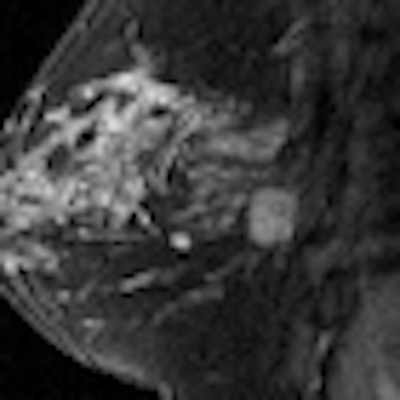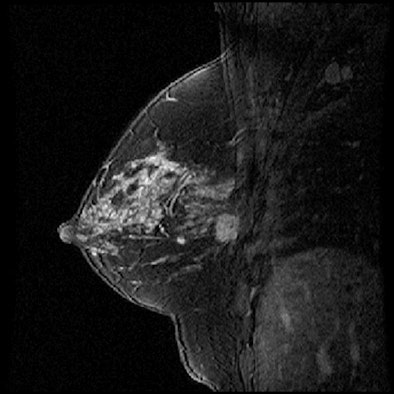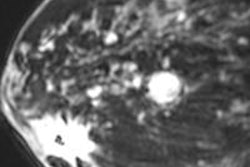
Certain tumor features as seen on contrast-enhanced breast MRI may be predictive of breast cancer recurrence, potentially helping clinicians assess prognosis and determine the most appropriate treatment, according to a study from the University of Pennsylvania.
Researchers found that multifocality and tumor size were most influential in determining which patients had a greater chance of breast cancer recurrence.
 Dania Daye from the University of Pennsylvania.
Dania Daye from the University of Pennsylvania.
"With the multiplication of treatment options for breast cancer, it is now becoming more critical to have methods to select patients who have high benefit-to-risk ratios from the available options," said lead author Dania Daye, an MD-PhD candidate at the Perelman School of Medicine, who presented the study's results at RSNA 2012.
Radiologists currently determine a patient's prognosis using morphologic factors such as tumor pathology, tumor size and grade, and nodal status. These factors have their limitations, however.
"Although useful, prognostic methods remain limited, and there is a need to identify additional prognostic factors to help treatment decisions for breast cancer patients," Daye said.
Molecular profiling
Molecular profiling is seen as one potential avenue for predicting breast cancer recurrence risk. Daye's study included the Oncotype DX breast cancer assay from Genomic Health, which is designed to measure the expression of 21 different genes based on samples culled from primary breast cancer tissue.
The assay's findings can separate patients into three risk groups and help predict 10-year breast cancer recurrence risk. When the score is less than 18, patients are considered low risk for breast cancer recurrence. With a score between 19 and 30, patients have a medium risk of recurrence. A score greater than 30 means patients generally are at high risk for recurrence.
In her presentation, Daye cited a 2006 study which found that patients with an assay risk stratification score greater than 30 were significantly more likely to benefit from chemotherapy (Journal of Clinical Oncology, August 10, 2006, Vol. 24:23, pp. 3726-3734).
"This highlights the importance of this test in treatment decisions for breast cancer patients," she said.
The study that Daye presented at RSNA 2012 evaluated 61 patients with a mean age of 55 years (range, 37 to 74). The patients had node-negative, estrogen-receptor-positive breast cancers.
All 61 women had previously undergone Oncotype DX profiling of their tumors. Among the patients, 25 (42%) were in the low-risk category, 14 (22%) were in the moderate-risk category, and 22 (36%) were in the high-risk category.
Breast MR images were acquired on a 1.5-tesla scanner (Excite, GE Healthcare, or Sonata, Siemens Healthcare) with a slice thickness ranging from 2.4 mm to 4.4 mm.
 |
| Contrast-enhanced 1.5-tesla MR images show a patient at low risk of breast cancer recurrence (above) and a patient at high risk (below). |
 |
Tumor assessment
Daye and colleagues analyzed seven characteristics of the tumors as seen on MRI: size, multifocality, shape, margin morphology, enhancement amount, enhancement kinetics, and associated nonmass enhancement.
Two clinical radiologists interpreted the images, and their scores were averaged to predict the category of cancer recurrence risk. Reader agreement was assessed using Cohen's kappa analysis.
The researchers then examined the agreement between the recurrence risk as predicted by the readers' interpretation of the MRI scans and the risk predicted by the Oncotype DX assays, Daye explained. Linear discriminant analysis (LDA) was used to determine the association between tumor features and the Oncotype DX recurrence risk category; performance of the LDA model was assessed using receiver operator characteristics (ROC) analysis.
Daye and colleagues found that of the MRI-based tumor features, multifocality and lesion size were most significant in predicting the recurrence risk categories on the Oncotype DX assays (p < 0.05). Using three of the MRI tumor features, including multifocality and lesion size, produced the most significant agreement in predicting the Oncotype DX recurrence risk categories (kappa = 0.41, p = 0.01).
The ROC analysis also showed the ability to distinguish between the three risk categories. The area under the curve (AUC) values were 0.64 for low versus intermediate risk, 0.66 for intermediate versus high risk, and 0.76 for low versus high risk.
"The best performance that we observed was distinguishing between the low-risk and the high-risk patients, with an AUC of 0.76," Daye said. "This is where most of the clinical relevance might be seen, in terms of distinguishing between the patients who will benefit the most and the least from chemotherapy treatment."
Based on the results, the researchers concluded that breast MRI tumor features could help predict breast cancer recurrence, with multifocal and larger lesions appearing to increase risk. When combined in a linear discriminant analysis model, the tumor features can predict the risk category of the Oncotype DX assay, according to the group.
Daye and colleagues plan to continue their research with larger clinical studies and patient follow-up.
"We hope to correlate with actual breast cancer recurrence, rather than using the Oncotype DX assay as a surrogate predictor of recurrence," she said. "Our long-term goal is to integrate imaging, genomic, and histopathology markers to improve prognostic assessment of breast cancer patients."
The study was performed under the supervision of Despina Kontos, PhD, director of the computational breast imaging group in the department of radiology at the University of Pennsylvania.
|
Study disclosures Two study co-authors have received research support from Hologic, one of whom is a research consultant for the company. A third study co-author is a consultant with GE. |


.fFmgij6Hin.png?auto=compress%2Cformat&fit=crop&h=100&q=70&w=100)





.fFmgij6Hin.png?auto=compress%2Cformat&fit=crop&h=167&q=70&w=250)











